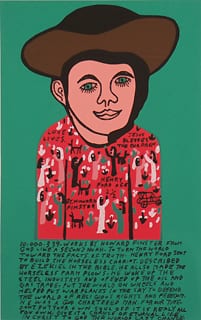
- This event has passed.
Howard Finster

Selections from the LUAG Teaching Collection/ OUTSIDER ART
A self-proclaimed “Man of Visions,” Howard Finster (1916-2001) was one of America’s most widely known and prolific self-taught artists, producing over 46,000 pieces of art before his death in 2001.
Born in rural Alabama in 1916, Finster went on to become a preacher, tent revivalist, and “master of 22 different trades” before building his roadside tribute to inventors, the Plant Farm Museum. Later dubbed “Paradise Garden” by Esquire magazine, this rock- and junk-encrusted wonderland was the focus of Finster’s life work. In 1976, however, this focus shifted slightly. As he was using his hands to apply paint to a refurbished bicycle, Finster noticed that the paint smudge on his finger had created a perfect human face. A voice spoke to him, saying, “paint sacred art.” In response, Finster churned out thousands of sermon-laden artworks with subjects ranging from historical characters and popular culture icons like Elvis Presley to evangelistic fantasy landscapes and futuristic cities. Most works are meticulously covered in Finster’s own hand-lettered words and biblical verse, recording visionary prophesies and providing glimpses of a celestial outer space world that Finster believed God had revealed to him.
Finster’s preaching experience and showman-like personality helped shape his public persona and ever-increasing celebrity. To spread his vision beyond Paradise Garden, Finster designed record album covers for rock groups such as R.E.M. and Talking Heads. Interviews, films, and his famous appearance on The Tonight Show with Johnny Carson further advanced his evangelical message.
The industry of promotion and production that surrounded Finster’s name ended up defining his final years. Though he continued to create many fine works, some critics felt that the quality of his work suffered. However, Finster’s intentions remained true to his inner voice—to make sacred art. Well-known and misunderstood, his position remains polarized, suspended somewhere between awe for his tireless, faith driven creativity and reluctance by the art community to accept his place in the pantheon of contemporary art.




